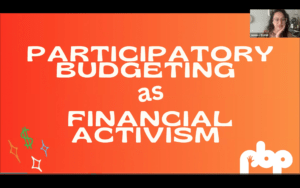
With a population just under 10,000, participatory budgeting has made its way in the town of Hinton, Alberta. Its recent cycle engaged residents to manage $100,000 of the public budget to fund town infrastructure and programs that benefit the community. The office of Mayor Mackin from the Town of Hinton shares lessons learned from adapting the PB model to meet local needs and allowing for a successfully engaging process. Check out the blog they released below:
There is an opportunity for every community in North America, to encourage community engagement in governance, show transparency, and grow leaders. This opportunity opens up an entirely new means of communication between governments and their people, and empowers local groups to identify problems and develop solutions to them. It follows a tested formula that is spreading through communities worldwide and has been in use since the 1980s. The formula is scalable, from small Albertan communities through metropolises, and adaptable to target youth and other marginalized groups. The opportunity is known as Participatory Budgeting.
Participatory Budgeting takes a portion of municipal funding and challenges residents to choose where to spend it best by earning the votes of their neighbours to make their ideas reality. And while the process is sure to provide most, if not all, of the above mentioned benefits, The Town of Hinton also recommends that all communities consider the full breadth of the process, and the implications of decisions to come from it, before trying out this concept.
In our first year, Hinton’s Participatory Budgeting process was very open. As a result, we found ourselves trying to mitigate a number of concerns that were discovered as we carried out the process. The question of ownership of facilities, or goods purchased through participatory budgeting, questions of whether all facilities and projects to receive funding need to be open to the public, and the question of who gets to vote are just a sample of decisions that need to be made ahead of time. These decisions not only direct where the funds will go, but also play a role in the level of citizen engagement.
Our second year is evidence of the impact these decisions create. When the Town narrowed the scope of how the funds could be used, we went from nearly 10% of the population voting to barely 1%. When we attempted a Participatory Budgeting process in 2015, it came with the condition that all applications be for town owned and managed facilities and programs. And while this meant that the town was now protected from a situation where it would have to absorb a facility, equipment or program should the group that had championed it fold, it also meant that the creativity, the potential to do anything, was also gone. The fears were gone; but so were the ideas, the passion, and the creativity that got the community involved in the concept.
Our next iteration, which is only in its infancy now, will aim to find a middle ground. We have asked an existing Community Engagement and Advisory Committee to review our PB experiences and provide feedback and recommendations to improve the process. A place that empowers our residents, while being wary of the real concerns that admin and council found over the last two years. Our number one piece of wisdom to pass on would simply be allow the community the freedom and latitude to brainstorm and come forward with ideas to enhance the community; engage them through the entire process of evaluating costs, benefits, etc; and to ensure that you have adequate time and resources to make the ‘process’ a success and not just the end result. Take the time to consider all the variables, consult with communities that have held participatory budgets, and make sure to consider what makes PB a good fit for your community. Aim to find solutions that merge the ideologies of participatory budgeting with the reality of your community’s needs. Participatory budgeting is now in its infancy, but it has the potential to become an idea practiced in all governments aiming to grow in their transparency and community engagement, should it be executed properly.




